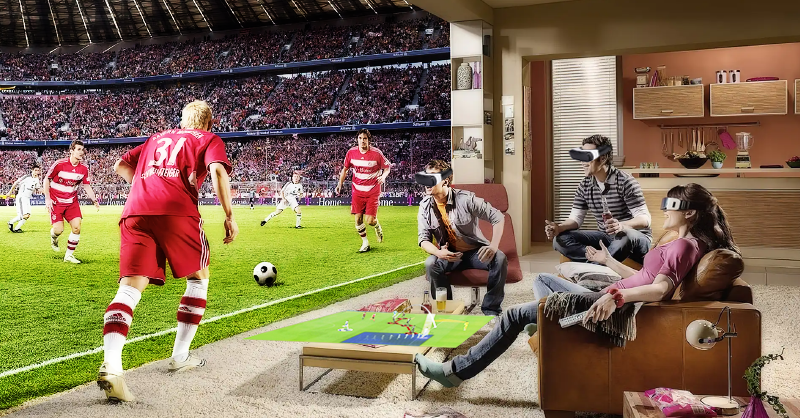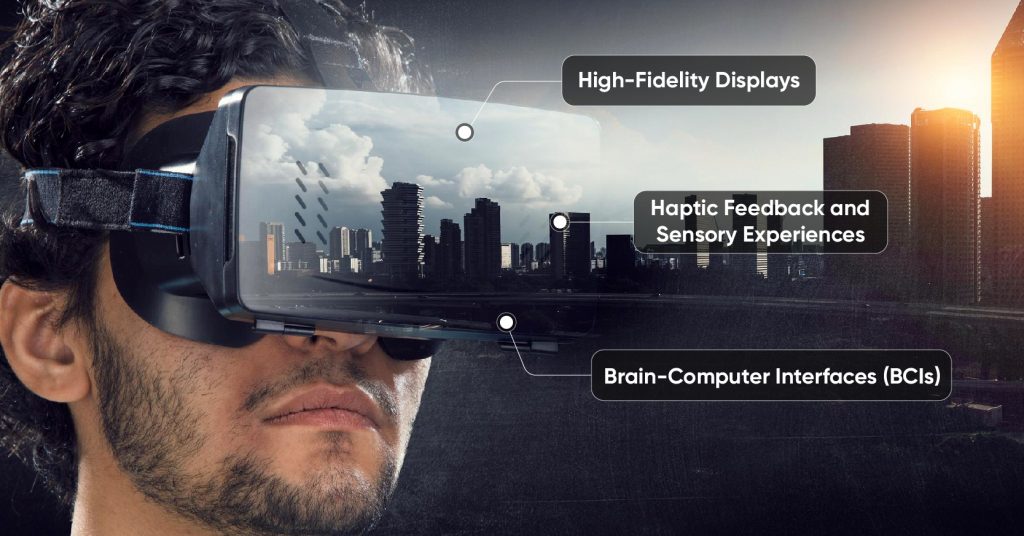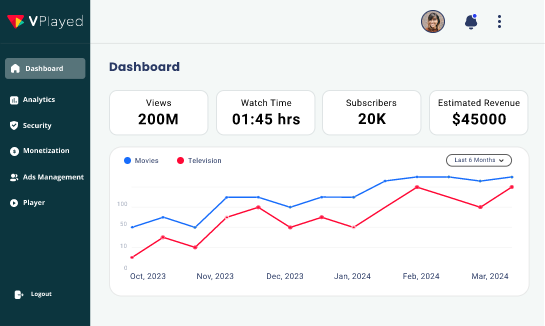Exploring Metaverse: Futuristic Insights into Virtual and Augmented Reality

Ever dreamt of visiting the farthest regions of the globe or swimming with the sharks in the depths of the ocean? Virtual Reality (VR) makes these experiences (almost) a reality!
Table of Contents
Understanding Virtual Reality (VR)
VR uses dedicated devices and software to create immersive, tech-generated simulations that lets you escape reality and enter a virtual paradigm.
From gaming, entertainment, education, therapy and training, VR enabled technologies are made use of everywhere, opening up a whole new world of possibilities.
Exploring Augmented Reality (AR)
Augmented Reality (AR) could create such an experience that blurs the line between the physical and digital elements. AR overlays computer-generated elements onto the real world.
Applications of AR have already found its way into our daily lives across multiple industries.
From revolutionizing providing visualization for city-planners and engineers with 3D overlays to adding a surreal yet convenient try-on feature in shopping & e-commerce.
Distinguishing Between Virtual Reality and Augmented Reality
VR & AR are both advanced technologies that have revolutionized the way we interact with the digital world forever.
Here are few of the key differences and surprising similarities between AR & VR:
Key Differences
VR significantly stands out in its ability to completely transport the user to a virtual world, escaping from all elements of reality.
AR on the hands retains reality while overlaying selected elements to complement the surroundings.
Similarities
Both VR and AR creates a unique addition of digital elements to create a sense of escaping reality for the human mind.
Technological Requirements of VR and AR
The world of VR & AR is truly surreal. However this raises the question as to how this magic happens?
Let us explore the software that creates this awe and the hardware that brings this wonder to life.
Hardware
VR Components
VR headsets consist mainly of two components. Firstly, the device that provides visual elements. Secondly, a component to receive interactions from users to control the simulation. VR glasses have also begun to gain popularity among VR enthusiasts.
AR Devices
AR does not need any specific devices to be accessed. The technology can be accessed through a multitude of devices such as smartphones, tablets, smart glasses, TV & Firestick, etc.
Software
Specific software & platforms is designed and utilized to bring about the VR & AR elements to life.
Game Engines
Most developers that work on VR & AR make use of software toolkits called game engines. The various visual elements, virtual environments & interactive options are made possible through this toolkit.
Content Creation Platforms
Generic content creation platforms would not be able to support AR & VR content. The various detailing required for element sculpting and 3D models requires dedicated software.
VPlayed, one of the leaders in providing streaming solutions such as OTT Platform, Video on Demand platform, Online Video Platform, Live Streaming & Whitelabel Streaming has always updated itself to the latest technologies and is positive to support VR & AR based content very soon.
Software Development Kits (SDKs)
The necessary tools and resources required by developers to build the apps and design experiences across platforms is available in these predefined kits.
Real-World Applications of VR and AR
VR and AR aren’t just about visually pleasing elements found in exhibitions. These novel developments have already begun finding their place across multiple verticals.
Let’s check out few of the many real-world applications of VR and AR:
Entertainment and Gaming
While VR is slowly making its way into almost every possible industry, the world of gaming is the one that has gained the most development.
VR headsets such as playstation VR devices and apple VR almost transport the gamers into a different world offering a deeply immersive experience, putting them right in the middle of the action.
In addition to gaming, virtual tours have also gained momentum and are accessible without any dedicated devices through AR technology.
Education and Training
An engaging and interactive experience can inspire young minds much more than what it could offer to adults.
Ultra-realistic models and experimental studies under controlled environments can be offered by Virtual Reality devices.
Whereas AR can revolutionize textbook learning through 3D overlays. Moreover, simulative visualizations can reach heights never done before.
Healthcare and Medical Simulation
AR’s ability to provide real time updates and data of patients to surgeons while performing surgery could work wonders in the medical field.
Meanwhile, VR can be utilized by medical students to gain nearly real-life pracrice through an immersive environment.
VR can also be harnessed by therapists to manage mental health and help patients in managing fears and pain.
Retail and Marketing: Redefining the Customer Experience
Interacting with products before purchasing them can elevate the shopping experience massively.
The virtual try out feature can transform the efficiency of the online e-commerce sector, avoiding the wastage of valuable resources.
Current Reality of VR & AR
Venturing into VR & AR opens doors to a world of futuristic wonder. While these technologies have already enchanted millions, they’re still very much evolving.
Nevertheless, there is a long way to go for either of these technologies before it could be accessible to everyone.
Furthermore, as in the case of any evolving technology, there are few significant limitations to be discussed.
Emerging Trends and Innovations
With the evolution of any technology there are few key innovations that completely revolutionizes the further progress in the domain. These are few of the trends that are believed would be turning points in the world of VR & AR.

High-Fidelity Displays
These are ultra high resolution displays that one day hopes to blur the boundaries between reality and the virtual world.
Tech experts hope to achieve this by keeping on pushing the resolution and field of view.
Haptic Feedback and Sensory Experiences
VR & AR have made significant waves in immersing our views with virtual elements. Haptic feedback hopes to do the same for sensory elements as well.
Offering a sense of touch, heat, pain & smell is what this technology is working towards.
Brain-Computer Interfaces (BCIs)
This would be the ultimate achievement that anyone involved in these technologies would hope to achieve one day. Understandably, the concept is very much in its early stage.
BCIs once developed would offer the user the ability to simulate virtual elements purely with their thoughts.
Addressing Technical Limitations of VR and AR Experience
Despite their vast potential, Virtual Reality and Augmented Reality technologies still face some technical hurdles.
Latency & Motion Sickness
The delay between the user’s input and the response in the virtual world is one of the most frustrating aspects of today’s virtual experience.
This latency between the eye’s perception and the inner ear movement can result in dizziness or disorientation.
Field of View and Resolution Limitations
While today’s technology seems futuristic to most people, there is always room for improvement.
The limited field of view and the quality of visuals in devices along with cost constraints is something that is sure to evolve in the future.
Ease of Use
The current VR devices are mostly uncomfortable to wear for prolonged intervals, let alone be capable of permanent usage.
Devices in the future should hope to address this concern and also should be made sure to be accessible by everyone.
Predictions for the Future of VR and AR
The road ahead for VR and AR provides a whole new world of possibilities. Here are a few predictions of what we can hope to achieve in the future:
Convergence of VR and AR
This is something that could be achieved sooner rather than later, with a multitude of organizations invested in
The capability to seamlessly transition between the real world augmented with virtual elements and a completely virtual world is already thrilling to envision.
The Rise of the Metaverse
This concept has continued to evoke awe for ages now, thanks to numerous science fiction films centered around the concept.
However the metaverse – a persistent world of virtual reality where users can engage and interact with other users and virtual elements is something for the distant future.
Conclusion
Virtual & Augmented Reality has taken human interaction with technology to a level never seen before. While these immersive technologies are certain to revolutionize every possible industry, the limitations of these technologies now can not be denied. With continuous improvements of these technologies and network, the line between the physical world and virtual world will grow thinner and thinner creating unprecedented possibilities.
